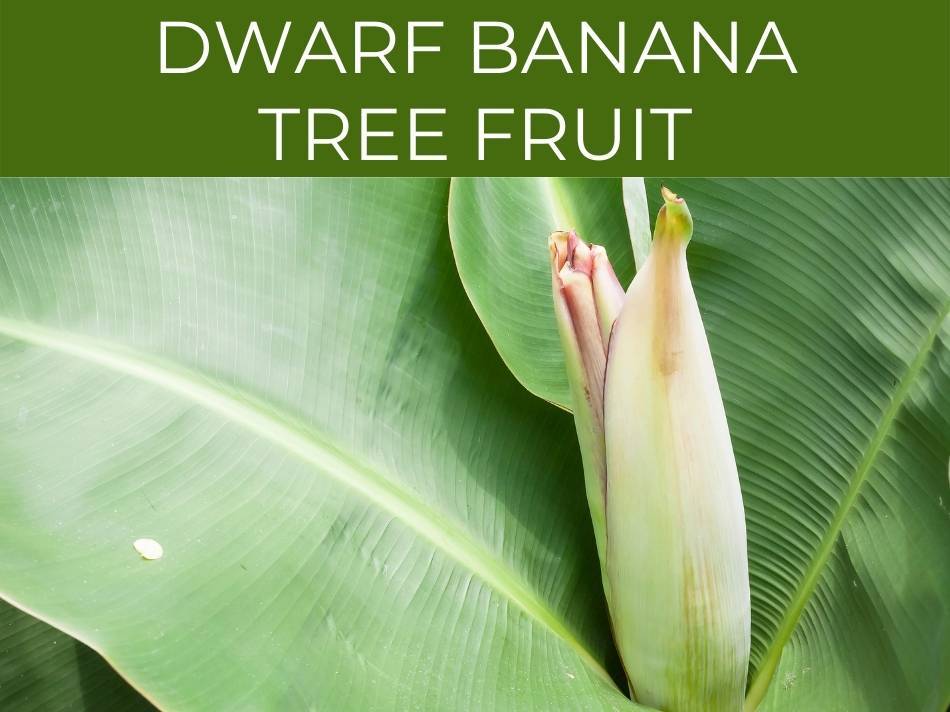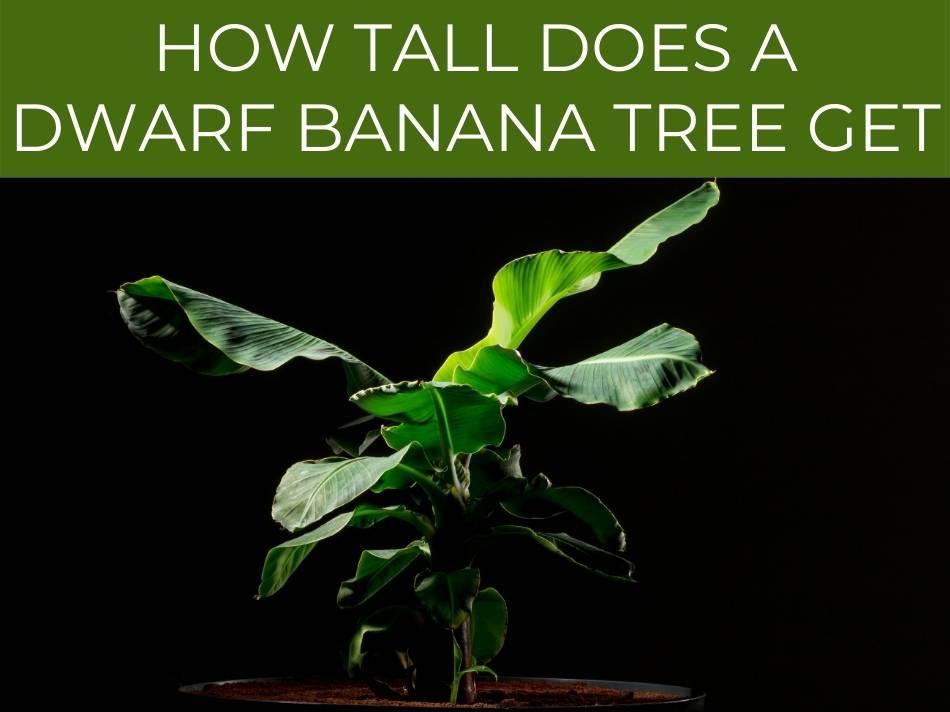For a taste of the tropics, you might like to have a dwarf banana tree. If you like a houseplant with lush green leaves and a tropical look, a dwarf banana tree is what you’re looking for. Plus, you might even get edible bananas, with a few tricks.
A dwarf banana tree is essentially the same as other banana trees, but typically grows to 3 – 6 feet tall. They can produce large amounts of bananas, and are generally less aggressive than the standard sized varieties. Dwarf banana trees require high nitrogen & potassium to produce fruit.
Keep reading to get answers for questions like:
- How is the dwarf banana tree different from the standard banana tree?
- How do you grow one?
- How did the dwarf banana tree come about?
- Are there different varieties?
- How big do they get?

Dwarf banana tree
So, what is a dwarf banana tree?
A dwarf banana tree is a perfectly “normal” banana plant that grows to be about 3 – 6 feet tall.
It can produce very large amounts of bananas, and it is generally less aggressive than the standard sized variety–making it a valuable addition to any garden.
Interestingly, calling it a banana “tree” is a bit of a misnomer.
Though standard banana trees can be as tall as 30 feet, the central stalk is more fleshy than woody, the entire plant being herbaceous. Broad, deep green, paddle shaped leaves grow out of a stalky center.
The banana fruits are, technically speaking, berries.
These are tropical plants that developed in rainforests, so they need a lot of humidity but not to the point that the soil is soggy. You can check out our complete article on rainforest soil types.
Bananas were first cultivated around 8000 BCE in New Guinea, and Arab traders brought them to the Western world in 327 BCE.
Wild bananas are so seedy as to be practically inedible to humans.
However, careful cultivation has created the soft, sweet, seedless fruit we all know and love.
Further cultivation has created dwarf varieties of banana trees suitable for the hobbyist horticulturist.
These varieties vary in height depending on variety and the kind of care received, but should be no taller than 10 feet in order to be classified as “dwarf”.
The 3 most common dwarf varieties of the banana plant are:
- Dwarf Cavendish banana tree
- Musa red banana tree (although these can sometimes grow taller than 10 feet).
- Dwarf ice cream banana tree
As it is a tropical plant, it thrives in high humidity conditions.
Novice plant owners will find that the dwarf banana tree is relatively easy to care for.

Banana tree vs. dwarf banana tree
A dwarf banana tree is pretty much indistinguishable from a full sized banana tree, except that it’s smaller.
Compared to regular banana tree varieties, dwarf banana trees typically grow 3 – 6 feet tall.
The only difference is that with a dwarf banana tree, you don’t have to climb a dwarf tree to pick the fruit: it’s in easy reach.
Even the fruit is the same size, texture and flavor.
Watering a dwarf banana tree will also be easier as you just need to do some occasional misting.
The yield of a dwarf tree will be significantly smaller, however.
A full sized tree can bear as many as 240 bananas in one go.
A dwarf tree in premium conditions may only produce 100 bananas.
That’s a lot of banana pudding!

Dwarf banana tree varieties:
Let’s look at three banana tree varieties and their dwarf counterparts.
Dwarf Cavendish banana tree
This would be the typical yellow banana that most people are familiar with.
The lush leaves of the dwarf Cavendish can get anywhere from 2 – 4 feet long, and makes for a very good privacy bush.
It can get up to 8 – 10 feet in height when fully mature.
Musa dwarf red banana tree
The fruit of this tree looks odd, with a red skin and orange pulp, but it has a sweet and creamy texture and a delightful aroma.
It is a vigorous, fast-growing plant that at maturity can be anywhere from 4 – 24 feet tall.
For taller plants, you’ll either need to plant outdoors, or in a multi-story atrium.
Dwarf ice cream banana tree
The flavor of dwarf ice cream bananas has been compared to vanilla custard, leading to their sweet-sounding name.
It is also known as the blue Java banana due to a rather turquoise tint of the unripe fruit.
The tree can be anywhere from 4 – 11 feet tall.
Trees planted in the ground (i.e., outdoors) tend to be taller.

Dwarf banana tree fruit
Large, shady leaves are great, but most people get banana trees because they like bananas.
Dwarf banana trees usually produce fruit sooner than other banana trees.
In addition, the fruit that they produce is much smaller, and is typically seedless, like other edible banana varieties.
Dwarf banana varieties are perfect for folks who just want to try out growing one type of banana tree in their yard.
If you live in the right USDA growing right zone and your tree gets ample water, you’re sure to get more than enough bananas.

How long does it take for a dwarf banana tree to produce fruit
To produce fruit, dwarf banana trees first need to grow to mature size–usually when the plant has about 26 to 32 leaves. Then the dwarf banana tree will grow a flowering stalk.
After the flowering stalk and its flowers appear, they develop–without pollination–into clusters of fruits.
The time from flowering to edible fruit is usually 80 – 180 days, depending on temperature, banana tree variety, & soil moisture.

How to grow a dwarf banana tree
To grow your dwarf banana tree outdoors, plant it in the spring, 10 feet away from any walls.
Select a warm area that gets plenty of sunlight but doesn’t flood. Dwarf banana trees do best in full sun.
Dwarf banana trees can be planted as close as 8 feet from other dwarf banana trees but 20 feet or more from other plants and trees.
With potassium rich fertilizer, ample sunlight and four to six inches of water per month, you should expect your first harvest in a year or two after planting.
If planting indoors, dwarf banana trees need at least 4 – 6 hours of sunlight a day, so place it somewhere that gets southern exposure.
It needs lots of water, but don’t allow the roots of a potted plant to soak so long in water that they rot. The soil must be rich and well drained to prevent this.
Dwarf banana trees need high humidity, so, depending on your indoor humidity, you might need a humidifier–especially in winter, when indoor air is typically dry.
An outdoor plant will need mulch and protection from high winds.

Fertilizer for dwarf banana tree
Banana trees need a potash-based fertilizer which can also be used as a foliar feed. A high nitrogen fertilizer is also necessary.
For best results, you should fertilize on a monthly schedule.
Young plants will need less fertilizer.Something with just 65% to 75% strength will work for your young banana tree.

Dwarf banana tree hardiness zone
If you are planting your dwarf banana tree outdoors, you’ll do best if you live in zones 9 – 11.
Texas, Florida, Louisiana, California and all points south are good places to grow a banana tree.
If the tree is kept in a pot indoors or on a patio, it can be planted as far north as region 4.
If you’re growing in cooler zones, you’ll need to protect the banana tree, either with straw mulch or by covering the tree with burlap to insulate it against the cold.
You could also consider growing a dwarf fig tree: here’s our complete guide to cold-hardy fig trees.
Dwarf banana tree care indoors
A banana tree kept indoors can thrive if given sufficient sunlight and water.
If you’re curious, check out the complete article on whether plants grow better in sunlight vs. artificial light.
You’ll need to keep your dwarf banana tree in a large container that is deep enough to accommodate the large root structure.
Soil with a pH level between 5.5 and 7 is ideal. Also, banana trees prefer warm temperatures–no colder than 67 degrees F.
And, you’ll have to keep the soil well-drained: a layer of pebbles on the bottom will allow humidity without soaking the roots.
If you’re looking for some greenery to liven up your bathroom, a banana tree would do well in such an environment, even if you do like steamy showers.

How tall does a dwarf banana tree get
The height of dwarf banana trees varies based on the particular variety, but many dwarf banana tree varieties grow 3 – 6 feet tall. The dwarf Cavendish variety gets around 8 – 10 feet tall.
Though a dwarf compared to the full sized tree it was spawned from, it is a bit tall but not so much as to be immovable.
Bringing a potted banana tree indoors for the winter may be something of a chore, but it’s doable.

Conclusion
The banana tree itself does best in warm climates, but it does not necessarily have to be near the equator.
While your banana tree must be warm, it must also be moist but not water logged.
It’s a bit of a balancing act, but a competent gardener should be able to cope with a dwarf banana tree.
At any rate, all the effort put into it is worth it for those luscious green leaves.
If you plant outdoors and do everything right, the tree may even reward you with a sweet, golden fruit.

